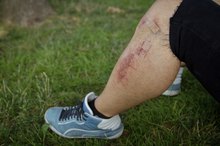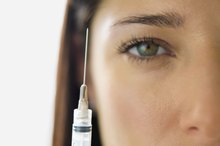Care of Skin After Cryosurgery
Cryosurgery is a medical procedure that involves applying a cold substance, typically liquid nitrogen, to the skin to freeze and destroy benign or malignant skin lesions 1. In most cases, cryosurgery is performed on an outpatient basis, and you may need multiple treatments over the course of several weeks or months. Recovery is generally uncomplicated, but infection, scarring, pigmentation changes, and numbness may develop following cryosurgery. Proper care of your wound is essential to minimize these risks.
If you are experiencing serious medical symptoms, seek emergency treatment immediately.
Leave your wound area exposed to air for the first 24 hours following your procedure, unless otherwise instructed by your doctor.
Care of Skin After a Mole Has Been Removed
Learn More
Clean your wound with antibacterial soap and warm water as soon as your doctor gives you permission to do so. You can remove scabs and crusted areas by wetting a sterile gauze pad with hydrogen peroxide and then gently rubbing it on your wound.
Replace your bandage immediately after cleaning your wound, and keep your wound covered until healing is complete. In some cases, you may need to wear a hydroactive bandage for the first few days or weeks following your cryosurgery procedure. This bandage contains a medication designed to speed healing and prevent infection.
Neosporin for Scar Removal
Learn More
Prevent infection in broken blisters by cleaning the area with antibacterial soap twice each day. Ohio State University recommends covering the spot with a small amount of petroleum jelly before applying a fresh bandage.
Take any medicines prescribed by your treating doctor, such as pain medications and antibiotics. You can take over-the-counter acetaminophen every three to four hours for mild pain.
Follow up with your doctor as scheduled, and call before your appointment if you develop multiple blisters, swelling, bleeding, redness or discharge in or near the wound site. Call your doctor right away if you develop a fever or increased pain. Seek emergency medical assistance if you experience severe bleeding.
Tips
Small wounds generally take two to three weeks to heal, while larger wounds may require a month or more of recovery, according to Drugs.com.
Related Articles
References
- Drugs.com: Skin Cryosurgery
- Mccaughan D, Sheard L, Cullum N, Dumville J, Chetter I. Patients' perceptions and experiences of living with a surgical wound healing by secondary intention: A qualitative study. Int J Nurs Stud. 2018;77:29-38. doi:10.1016/j.ijnurstu.2017.09.015
- Krafts KP. Tissue repair: The hidden drama. Organogenesis. 2010;6(4):225-33. doi:10.4161/org.6.4.12555
- Chetter IC, Oswald AV, Fletcher M, Dumville JC, Cullum NA. A survey of patients with surgical wounds healing by secondary intention; an assessment of prevalence, aetiology, duration and management. J Tissue Viability. 2017;26(2):103-107. doi:10.1016/j.jtv.2016.12.004
- Singh PK, Saxena N, Poddar D, et al. Comparative Study Of Wound Healing In Primary Versus Delayed Primary Closure In Contaminated Abdominal Surgery. Hellenic J Surg. 2016;88:314–320. doi:10.1007/s13126-016-0340-8
- Surgical Patient Education Program: Prepare for the Best Recovery. American College of Surgeons. 2018.
- Rushbrook JL, White G, Kidger L, Marsh P, Taggart TF. The antibacterial effect of 2-octyl cyanoacrylate (Dermabond®) skin adhesive. J Infect Prev. 2014;15(6):236-239. doi:10.1177/1757177414551562
- Lazar HL, Mccann J, Fitzgerald CA, Cabral HJ. Adhesive strips versus subcuticular suture for mediansternotomy wound closure. J Card Surg. 2011;26(4):344-7. doi:10.1111/j.1540-8191.2011.01257.x
- 3M Wound Resource Center. http://solutions.3m.co.uk/wps/portal/3M/en_GB/skin-care/wound-resource-centre/
Tips
- Small wounds generally take two to three weeks to heal, while larger wounds may require a month or more of recovery, according to Drugs.com.
Writer Bio
Sandra Ketcham has nearly two decades of experience writing and editing for major websites and magazines. Her work appears in numerous web and print publications, including "The Atlanta Journal-Constitution," "The Tampa Bay Times," Visit Florida, "USA Today," AOL's Gadling and "Kraze Magazine."









